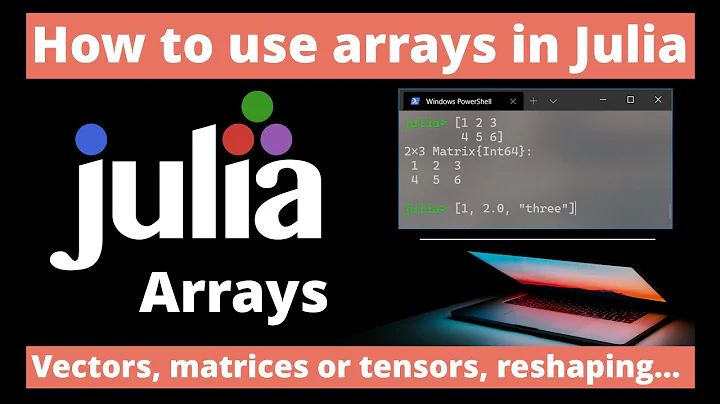What's the most efficient way to convert a Matrix{T} of size 1*N or N*1 in Julia to a Vector{T}?
14,966
Solution 1
You can use the vec() function. It's faster than the list comprehension and scales better with number of elements ;)
For a matrix of 1000x1:
julia> const a = reshape([1:1000],1000,1);
julia> typeof(a)
Array{Int64,2}
julia> vec_a = [x::Int for x in a];
julia> typeof(vec_a)
Array{Int64,1}
julia> vec_aII = vec(a);
julia> typeof(vec_aII)
Array{Int64,1}
6.41e-6 seconds # list comprehension
2.92e-7 seconds # vec()
Solution 2
I would tend to use squeeze to do this if the matrix is 1xN or Nx1:
squeeze(ones(3, 1))
squeeze(ones(1, 3))
Not sure if that's more efficient than using vec or reshape.
Solution 3
vec() is faster
const a = reshape([1:1000],1000,1);
@time vec(a);
elapsed time: 6.914e-6 seconds (184 bytes allocated)
@time squeeze(a,2);
elapsed time: 1.0336e-5 seconds (248 bytes allocated)
Related videos on Youtube
Author by
Ben Hamner
Updated on March 17, 2020Comments
-
Ben Hamner about 4 years
What's the most efficient way to convert a Matrix{T} of size 1*N or N*1 in Julia to a Vector{T}?
For example, say I have
a = [1,3,5] b = a'Both
aandbare of typeArray{Int,2}(i.e.Matrix{Int}). What are the most efficient ways to convertaandbto typeArray{Int,1}(i.e.Vector{Int})?One approach is:
a_vec = [x::Int for x in a] b_vec = [x::Int for x in b] -
StefanKarpinski over 11 yearsOne important thing to note about both
vecandreshapeis that they share memory with the underlying array for performance – that's whyvecis so much faster than a comprehension, which creates a new array object, copying content. Thus, if you changea[1],v_aII[1]will also change and vice versa, whereasv_a[1]will be unaffected. -
 Diego Javier Zea over 11 yearsGood, I didn't know about this function.
Diego Javier Zea over 11 yearsGood, I didn't know about this function. -
 Diego Javier Zea over 11 yearsSeeing in the definitions, looks like squeeze has to be a little more slow than the other. github.com/JuliaLang/julia/blob/master/base/… I do a little benchmark, and I found: squeeze(m) : ( 2.97 +- 2 ) e-6 seconds vec(m) : ( 2.02 +- 2 ) e-6 seconds reshape(m,length(m)) : ( 1.72 +- 2 ) e-6 seconds Difference is very very small, but how one can expect by definitions, reshape(m,length(m)) is the faster option.
Diego Javier Zea over 11 yearsSeeing in the definitions, looks like squeeze has to be a little more slow than the other. github.com/JuliaLang/julia/blob/master/base/… I do a little benchmark, and I found: squeeze(m) : ( 2.97 +- 2 ) e-6 seconds vec(m) : ( 2.02 +- 2 ) e-6 seconds reshape(m,length(m)) : ( 1.72 +- 2 ) e-6 seconds Difference is very very small, but how one can expect by definitions, reshape(m,length(m)) is the faster option.








